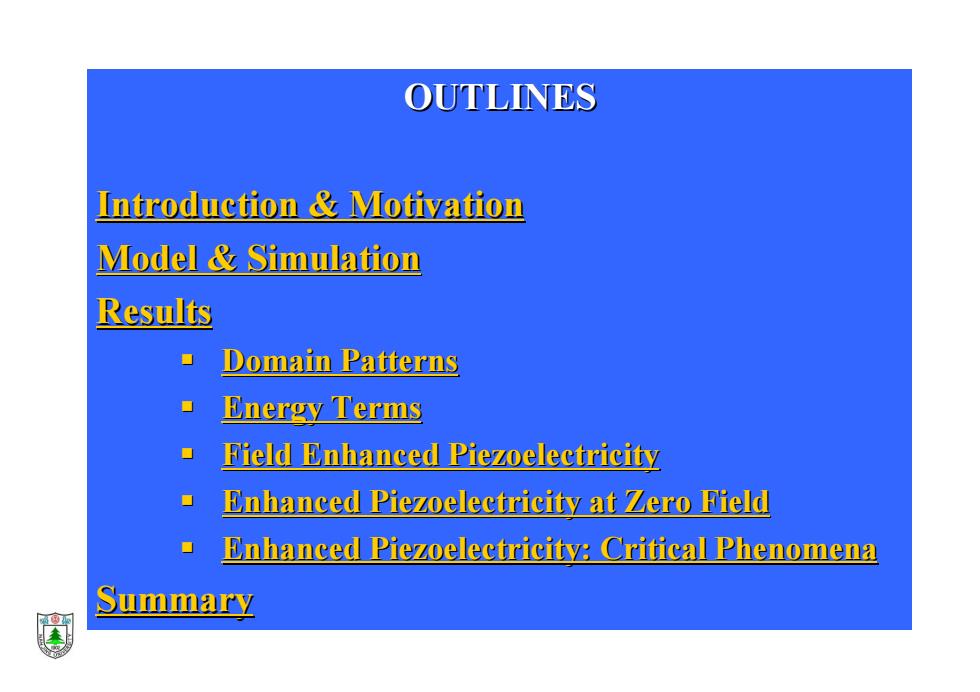
OUTLINES Introduction Motivation Model Simulation Results ·Domain Patterns Energy Terms Field Enhanced Piezoelectricity Enhanced Piezoelectricity at Zero Field Enhanced Piezoelectricity:Critical Phenomena Summary
OUTLINES OUTLINES Introduction & Motivation Introduction & Motivation Model & Simulation Model & Simulation Results Results Domain Patterns Domain Patterns Energy Terms Energy Terms Field Enhanced Piezoelectricity Field Enhanced Piezoelectricity Enhanced Piezoelectricity at Zero Field Enhanced Piezoelectricity at Zero Field Enhanced Piezoelectricity: Critical Phenomena Enhanced Piezoelectricity: Critical Phenomena Summary Summary
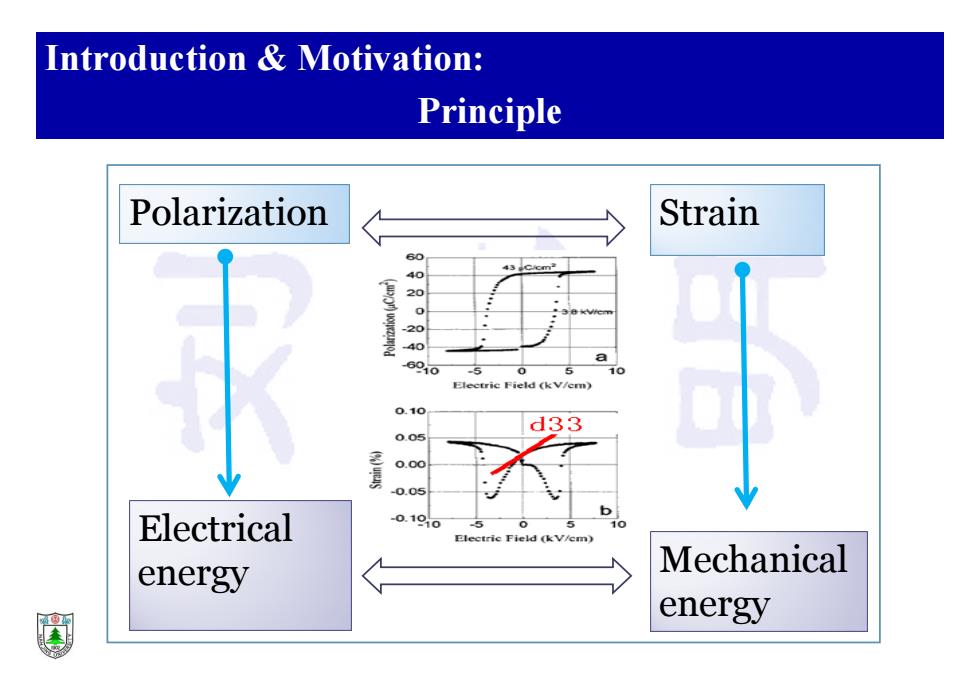
Introduction Motivation: Principle Polarization Strain A 43 60 10 ric Field (kV/cm) 0.10 d33 0.05 0.05 0.1010 b Electrical 5 10 Electric Field (kV/cm) energy Mechanical energy
Introduction & Motivation: Principle Polarization Strain Electrical energy Mechanical energy
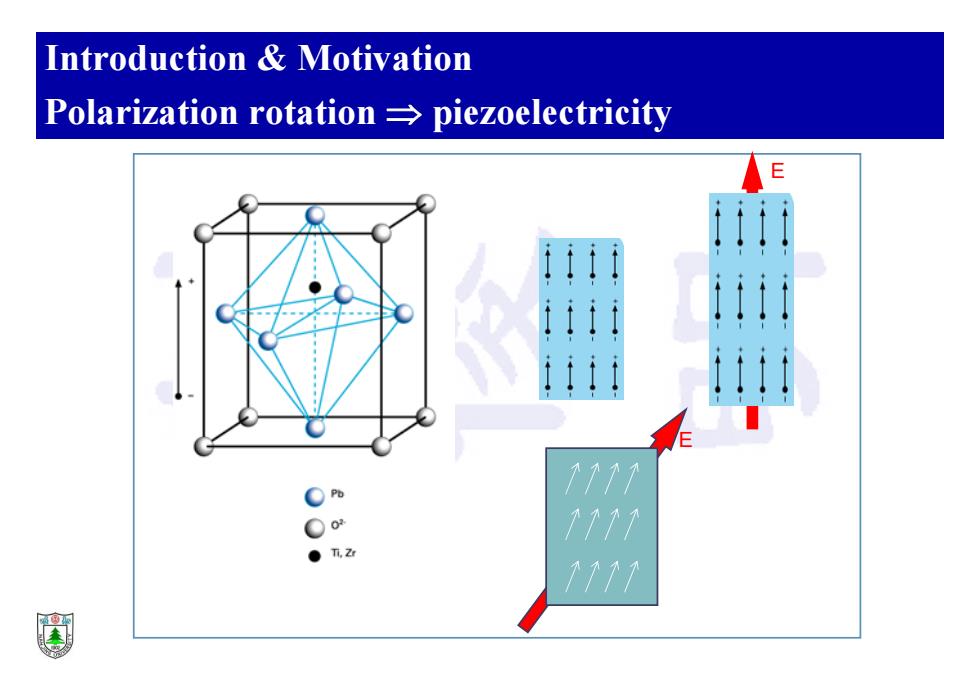
Introduction Motivation Polarization rotation piezoelectricity E 0 1111 ● 1111
Introduction & Motivation Polarization rotation piezoelectricity PZT E E
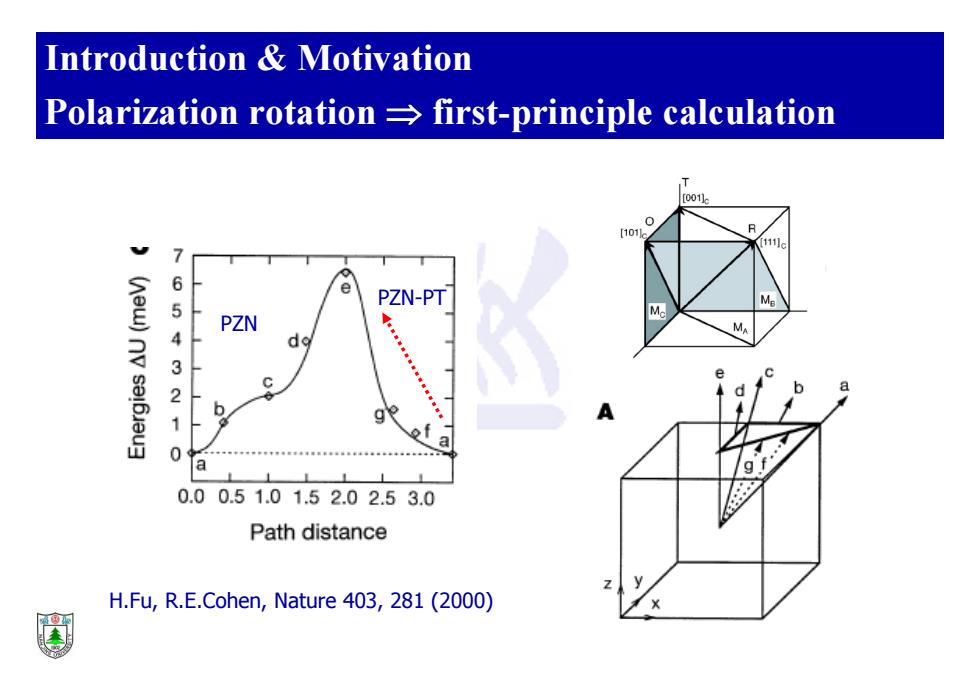
Introduction Motivation Polarization rotation first-principle calculation T [0011 0 [101 6 5 PZN-PT PZN 令 M 4 3 2 b 1 g 0.00.51.01.52.02.53.0 Path distance H.Fu,R.E.Cohen,Nature 403,281(2000)
Introduction & Motivation Polarization rotation first-principle calculation PZN PZN-PT H.Fu, R.E.Cohen, Nature 403, 281 (2000)

Introduction Motivation Relaxors dielectric response enhanced ferroelectricity 40000 o0.90PMN-0.I0PT 35000 a0.85PMN-0.15P7 30000 a0.82PMN-0.18PT ●0.70PMN-030PT 25000 ■0.65PMN-0.35P7 20000 ▲0.60FMN-0.40P1 15000 10000 5000 150 200 250 300 Temperature(C) 40000 35000 o K(I kHZ) 口K(1okHz) PMN-0.I5PT 30000 K (100 kHz) 25000 20000 15000 10000 5000 0 5 100 200 J.M.Kelly,PhD dissertation(1998).(A.Safari,Rutgers}
Introduction & Motivation Relaxors dielectric response & enhanced ferroelectricity J. M. Kelly, PhD dissertation (1998). {A. Safari, Rutgers}
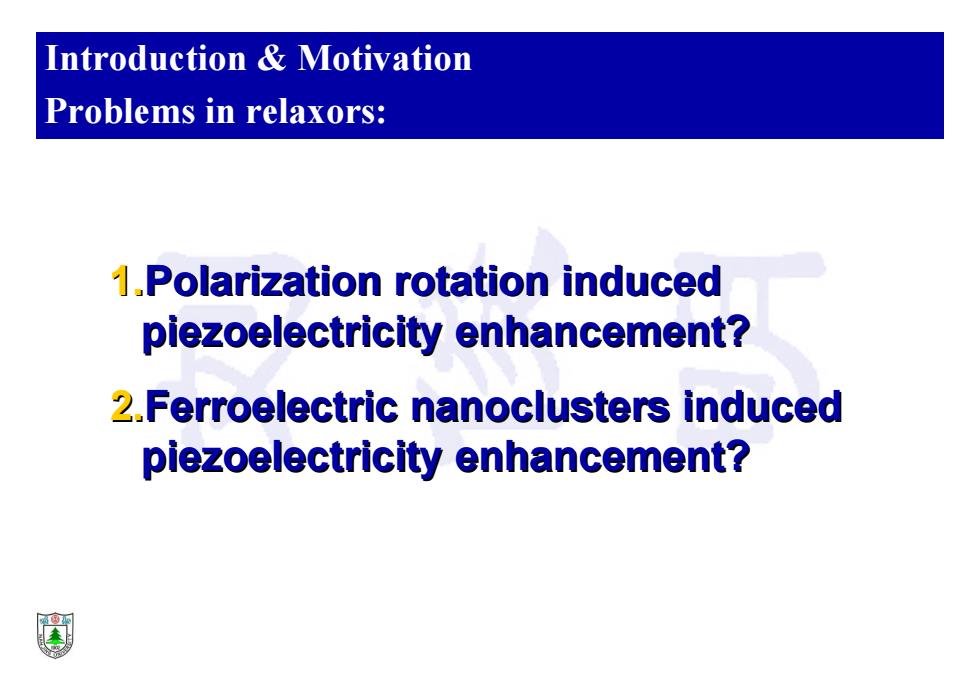
Introduction Motivation Problems in relaxors: 1.Polarization rotation induced piezoelectricity enhancement? 2.Ferroelectric nanoclusters induced piezoelectricity enhancement?
Introduction & Motivation Problems in relaxors: 1.Polarization rotation induced Polarization rotation induced piezoelectricity enhancement? piezoelectricity enhancement? 2.Ferroelectric Ferroelectric nanoclusters nanoclusters induced induced piezoelectricity enhancement? piezoelectricity enhancement?
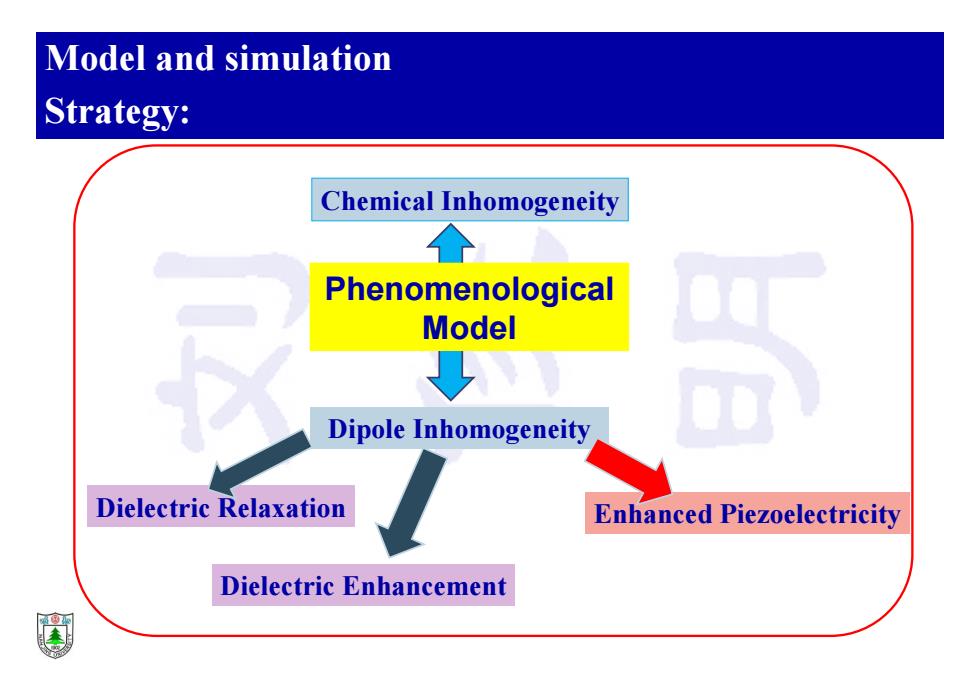
Model and simulation Strategy: Chemical Inhomogeneity 合 Phenomenological Model Dipole Inhomogeneity Dielectric Relaxation Enhanced Piezoelectricity Dielectric Enhancement
Model and simulation Strategy: Phenomenological Model Chemical Inhomogeneity Dipole Inhomogeneity Enhanced Piezoelectricity Dielectric Enhancement Dielectric Relaxation
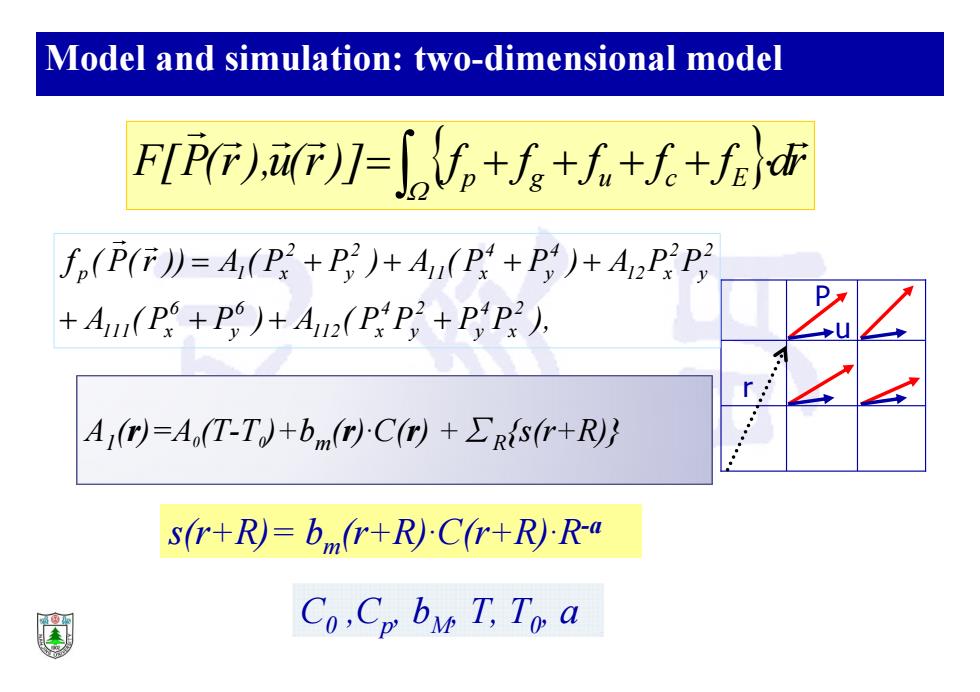
Model and simulation:two-dimensional model FF),F)=。+方++人+f面 f(P()=4(P+P)+Au(P+P:)+APP +Am(p+p)Au(P:+P) Aj(r)=Ao(T-T+bm(r)C(r)+>Rs(r+R) s(r+R)=br(r+R)-C(r+R)-R-a Co,Cp by T,To a
Model and simulation: two-dimensional model P u F[P(r), u (r)] f f f f f dr p g u c E A ( P P ) A ( P P P P ), f ( P ( r )) A ( P P ) A ( P P ) A P P 2 x 4 y 2 y 4 112 x 6 y 6 111 x 2 y 2 12 x 4 y 4 11 x 2 y 2 p 1 x A 1 (r)=A 0(T-T0)+b m (r)·C(r) + ∑R{s(r+R)} s(r+R)= b m(r+R)·C(r+R)·R-a C 0 ,Cp, b M, T, T0, a r

Model and simulation:two-dimensional model fa(P)-jlGi/P.+BJ+GiP.Py+G(P,+B.F+G(Py-B.F] PPi/or ,cG.+g,+Ca+号cG 2 un=ou;/or u=ou;/ori+ou;/or f4,PF月=-uhx-4y几n-4n a=QP2+02P, mwy=QnPy+Q12P:nky=Q4P:Py fg=-E-P
Model and simulation: two-dimensional model [ G (P P ) G P P G (P P ) G (P P ) ] 2 1 f (P ) 2 44 x,y y,x 2 12 x,x y,y 44 x,y y,x 2 y,y 2 g i,j 11 x,x Pi, j= ∂Pi /∂ rj C u , 2 1 C ( u u ) C u u 2 1 f ( u ) 2 12 x,x y,y 44 x,y 2 y,y 2 u i,j 11 x,x uii = ∂ ui /∂ ri, ui, j= ∂ uj /∂ ri + ∂ ui /∂ rj c i,j x,x xx y,y yy x,y xy f (u ,P(r)) u u u xx=Q11 Px 2+Q12Py 2 ; yy=Q11 Py 2+Q12Px 2 ; xy=Q44PxPy fE= −E·P

Model and simulation:procedure OP;(r,t)/ot=-Lp:8F/8P (r,1), Ou;(r,t)/Ot=-L8F/8u;(r,1), (i=x,y以 Initial State Unpoled State Poled State T>>T;E=0 T=0;E=0.0 pole T=0;E=0.0 T=T+△T T=T+△T E=E+AE E=E+AE
Model and simulation: procedure ∂Pi (r,t)/∂t= − L P·δF/ δ Pi (r, t), ∂ ui (r,t)/∂t= − L u·δF/ δ ui (r, t), (i=x,y) Initial State T>>T c; E=0 Unpoled State T=0; E=0.0 T=T+ ∆ T ZFC pole E = E + ∆ E T=T+ ∆ T E = E + ∆ E Poled State T=0; E=0.0